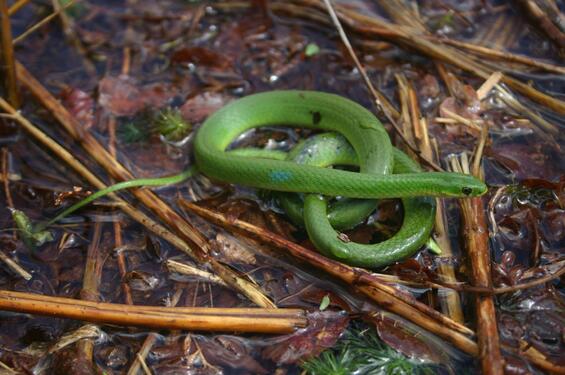- Scientific name: Opheodrys vernalis
Species of Greatest Conservation Need (MA State Wildlife Action Plan)

Adult smooth greensnake.
Description
The smooth greensnake is a slender-bodied snake that ranges in length from 30-51 cm (12-20 in), reaching a maximum of 66 cm (26 in). This difficult-to-confuse species in Massachusetts is identified by its uniform and green dorsal coloration, smooth scales, and white to pale yellow ventral coloration. The smooth greensnake also has a long and tapering prehensile tail.
Smooth greensnakes emerge in April or May and mate by late spring or summer. Females lay one to two clutches of four to six eggs, which are laid from June to September. Nests are located in rotting vegetation, beneath logs or flat stones, and in small mammal burrows. Young snakes are dark olive or blue-gray in coloration. Adult and young snakes are active until late September, when they spend the rest of the year hibernating below ground. Preferred hibernacula include rodent burrows and subsurface ant chambers. It is not uncommon for smooth greensnakes to overwinter communally with ring-necked snakes, Dekay’s brownsnakes, red-bellied snakes, and common gartersnakes.
Smooth greensnakes are active during the day and feed on a variety of arthropods (crickets, grasshoppers, caterpillars, beetles, spiders, centipedes, and millipedes).
Life cycle and behavior
Mating can occur in spring or summer, and females lay eggs between June to September. These snakes combine the advantages of live-bearing and egg-laying, partially incubating eggs internally so that they hatch just 1-3 weeks after they are deposited. Hatchlings are 10-15 cm (4-6 in) long. Clutches usually contain only about 3-6 young, but two clutches may be produced in a season. Communal nests containing multiple clutches have been documented. Smooth greensnakes primarily eat spiders, caterpillars, and other insects and arthropods.
Population status
The smooth greensnake does not have a federal conservation status under the MESA or the U.S. Endangered Species Act. However, it is recognized as a species of greatest conservation need in Massachusetts due to population declines and habitat loss.
Distribution and abundance
The species is not well documented in Massachusetts. It has a statewide distribution. Their densities are not well known, and they are not uniformly distributed. Most reports are from the Taconic Ridges, the Berkshire Plateau, coastal areas, Cape Cod, and the Islands.
Habitat
Smooth greensnakes may be found in a range of lightly forested habitats such as pastures, old fields, wet meadows, peat lands, bogs, coastal grasslands, edges of marshes and forests, pine barrens, blueberry barrens, grassy hilltops, rocky slopes, and open woodlands.
Healthy habitats are vital for supporting native wildlife and plants. Explore habitats and learn about conservation and restoration in Massachusetts.
Threats
The species has declined significantly in abundance during the second part of the 20th century; however, the exact causes are unknown. It is thought that it is due to loss and degradation of grassland habitats from land management practices (i.e., mowing frequency and insecticide use), forest succession, and development. It is also unknown if the unnaturally high densities of populations of “human commensals,” such as raccoon, skunk, and fox, created by development, are also a threat to this snake.
Conservation
Surveysare required to assess the abundance, distribution, and core habitat requirements of the species. It is also important to determine how populations respond to habitat management.
References
Gibbs, J.P., A.R. Breisch, P.K. Ducey, G. Johnson, J.L. Behler, and R.C. Bothner. 2007. The Amphibians and Reptiles of New York State: Identification, Natural History, and Conservation. Oxford University Press. New York.
Jackson, S., and P. Mirick. Undated. Massachusetts Snake Guide. Massachusetts Division of Fisheries and Wildlife and University of Massachusetts Cooperative Extension System.
Klemens, M.W. 1993. Amphibians and Reptiles of Connecticut and Adjacent Regions. State Geological and Natural History Survey of Connecticut, Bulletin 112. Connecticut Dept. Environmental Protection, Hartford, Connecticut.
Lazell, J.D., Jr. 1976. This Broken Archipelago. Quadrangle/The New York Times Book Company. New York, New York.
Contact
| Date published: | April 17, 2025 |
|---|